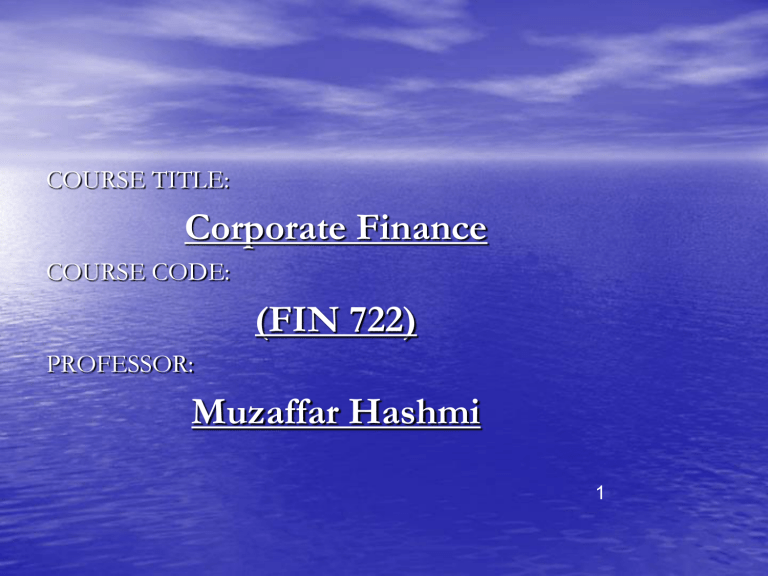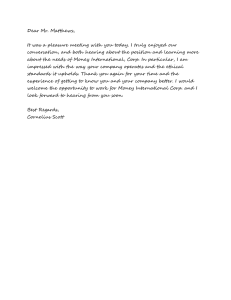Corporate Finance Course: Capital Budgeting & Valuation
advertisement

COURSE TITLE: Corporate Finance COURSE CODE: (FIN 722) PROFESSOR: Muzaffar Hashmi 1 Recommended Books Fundamental of Corporate Finance (7th Edition) By: Richard A Brealey, Stewart C Myers Principle of Corporate Finance (4th Edition) By: Richard A Brealey, Stewart C Myers Essential of Corporate Finance By: Stephen A Ross, Randolph W Westerfield, Bradford D Jordan Corporate Finance Scheme of Studies: • MODULE # 1 : OVERVIEW OF CORPORATE FINANCE • MODULE # 2 : VALUATIONS OF FINANCIAL INSTRUMENTS LIKE • • • • • • STOCKS SHARES & BONDS MODULE # 3 : CAPITAL BUDGETING MODULE # 4 : RISK STRATEGIES & MANAGEMENT MODULE # 5: COST OF CAPITAL MODULE # 6 : SHORT TERM FINANCE & CAPITAL STRUCTURE MODULE # 7 : SPECIAL TOPICS – MERGERS & ACQUISITIONS MODULE # 8 : INTERNATIONAL OPERATIONS Lecture 1: Module # 1: Introduction to Corp Finance TO START A BUSINESS - THREE QUESTIONS ARISES: • 1. What type of assets do we needs? • 2. Where the money will come from to buy these particular assets? • 3. Day to day or Routine financial expenses, how to meet them? 4 Lecture 1: Module # 1: Introduction to Corp Finance QUESTION # 1: SELECTION OF ASSETS: CAPITAL BUDGETING •CB is defined as process of planning, analyzing and acquiring of capital. 5 Lecture 1: Module # 1: Introduction to Corp Finance • CB decisions are irreversible in nature • SWOT Analysis : – S – Strength – W – Weakness – O – Opportunities – T – Threats • CB targeted towards potential opportunities Lecture 1: Module # 1: Introduction to Corp Finance • Opportunities of a Business Entity depends on nature of intended business • Example: Air line Industry wants to add an aircraft that generate more Cash Flows. (i.e. Opportunity and acquire an asset Plane) Cargo Company - Trawlers 7 Lecture 1: Module # 1: Introduction to Corp Finance Points keep in view by Financial Manager & CB • Size of Investment • Risk • Timing • Evaluating Size, timing of CF and Risk associated with CF is essence of CB 8 Lecture 1: Module # 1: Introduction to Corp Finance QUESTION # 2:Where to get money from to Finance Investment? Ans: CAPITAL & ITS STRUCTURE • Two ways to finance an Investment: – Owner’s Equity – Loans or External Sources 9 Lecture 1: Module # 1: Introduction to Corp Finance Terminology in Capital Raising IPO’s – IPO’s stands for Initial Public Offerings – Company launch their shares in market – Offer general Public – Share allotted on Draw Lecture 1: Module # 1: Introduction to Corp Finance QUESTION # 3 • How to manage routine financial activities? • Working Capital Basically Interaction between Current • • Assets & Current Liabilities Working Capital needs to meet financial expenses Current Assets - Current Liabilities = WC OPERATING CYCLE Cash Flow from Customers used to Pay Off Vendors Vendors Raw Material Finished Goods Sales to Customer Cash from Customers Cash Payment from Customers Difference between Operating Cycle and Cash Conversion Cycle (Cash Cycle) Operating Cycle: Operating cycle for a firm is the average number of days that the firm takes to convert its raw material into finished goods for sale and getting cash proceeds from debtors. Formula for operating cycle is: Operating cycle = Average days of inventory (stock holding period) + Average receivable processing period (in days) Cash Conversion Cycle: It is also termed as net operating cycle or simply the cash cycle. It starts from conversion of raw material into finished goods for sales and collection of cash from debtors to payback to their creditors/ suppliers. Cash Conversion cycle = Average days of inventory (stock holding period) + Average receivable days – Average payable processing period (in days) Note: Cash conversion cycle is always shorter than the operating cycle because here average payable days are subtracted form operating cycle. Lecture 1: Module # 1: Introduction to Corp Finance Working Capital Policies • Level of Inventory Investment • Credit extension policy Lecture 1: Module # 1: Introduction to Corp Finance Types of Business • Sole Proprietor Un-Incorporated Business • Partnership • Limited Liability Business: – Private Company – Public Un-listed Company Lecture 1: Module # 1: Introduction to Corp Finance Limited Liability Business & Markets Types of Markets: • Primary Market • Secondary Market Lecture 1: Module # 1: Introduction to Corp Finance Primary Markets • • • • • Original Sale of Securities and shares No tangible Shape General Public offerings Private placements IPO’s in Primary Market Lecture 1: Module # 1: Introduction to Corp Finance Secondary Markets • Subsequent to first sale or Subsequent to original sale. • Trading of Securities & Shares • Tangible Markets • Example stock Exchange Lecture 1: Module # 1: Introduction to Corp Finance FINANCIAL STATEMENTS & CORPORATE FINANCE •THREE BASIC STATEMENTS BALANCE SHEET INCOME STATEMENT CASH FLOW STATEMENT Lecture 1: Module # 1: Introduction to Corp Finance BALANCE SHEET • Is a Statement of resources controlled by the business entity and obligations on a specific date. Lecture 1: Module # 1: Introduction to Corp Finance Contents of Balance Sheet • Assets = Fixed (tangible & intangible)& current assets • Liabilities = Long Term Liability + Current Or Short Term Liability • Equity = shareholders’ contribution + earnings Lecture 1: Module # 1: Introduction to Corp Finance Fixed Assets: • Earning assets • Fixed Assets e.g. Plant, Machinery, Vehicles etc Current Assets: • Inventory, Prepayments, Cash & Bank Balance, Short Term Investment etc Lecture 1: Module # 1: Introduction to Corp Finance Balance Sheet Format • Format of B/S in Pakistan is Governed by International Financial Reporting Standard or International Accounting Standard • B/S construction is Non-liquid or Illiquid Asset is at top Lecture 1: Module # 1: Introduction to Corp Finance Two Conventions for B/S Construction • 1st as in Pakistan IAS or IFRS • 2nd Convention GAAP (General Accepted Accounting Principle) applicable in United States • GAAP – In B/S top item is highly liquid asset i.e. cash or near money Lecture 1: Module # 1: Introduction to Corp Finance Current Liabilities ingredients • Creditor, Accrued Liabilities, Short Term Finances • Current Assets - Current liabilities equal Working Capital Lecture 1: Module # 1: Introduction to Corp Finance Liquidity • • • • Conversion into cash without losing its value. Timing Loss of value Example: Bonds Lecture 1: Module # 1: Introduction to Corp Finance Equity & Long Term Liabilities • Equity – Paid up Capital – Reserves – Profit & Loss • Long Term Liabilities – Loans OR Financial Leverage BALANCE SHEET AS AT 30 JUNE 2003 NOTES OPERATING ASSETS Fixed assets (at cost less accumulated depreciation) DEFERRED COST LONG TERM DEPOSITS (against Lease) 2003 RUPEES 2002 RUPEES 3 125,138,737 109,101,363 4 12,653,681 2,930,337 140,722,755 18,514,377 827,737 128,443,477 7,347,476 22,628,137 2,149,858 11,215,891 19,231,731 3,211,998 7 8 26,089,950 107,524 58,322,945 17,450,008 110,421 51,220,049 9 (6,794,240) (8,004,000) (6,760,139) (30,831,550) (2,821,322) (19,270,244) (44,786,359) CURRENT ASSETS Stores & spares Stocks -doTrade debtors Advances, deposits, prepayments and other receiveables Cash and bank balances CURRENT LIABILITIES Current maturity portion of lease liability Current maturity portion of Long Term Loans Short term borrowings Creditors, accruals and other liabilities 5 6 10 11 TOTAL ASSETS LESS CURRENT LIABILITIES LONG TERM LIABILITIES Deferred Income Due to directors and relatives Provident fund trust and gratuity payable Long term loans Dealers&Distributors securities Long term portion of leasehold assets 146,655,771 (1,692,510) (37,056,700) 12 (926,457) 13 (27,828,000) 14 (23,871,350) (12,710,887) (104,085,904) TOTAL NET ASSETS REPRESENTED BY : Share capital (5,980,000) Profit & (loss) account Surplus on revaluation of fixed assets Share deposit money 42,569,867 15 112,785,601 (21,693,585) (926,457) (47,500,000) (19,398,600) (1,936,847) (91,455,489) 21,330,112 59,800,000 39,800,000 (27,457,311) (29,697,066) 8,227,178 8,227,178 2,000,000 3,000,000 42,569,867 21,330,112

